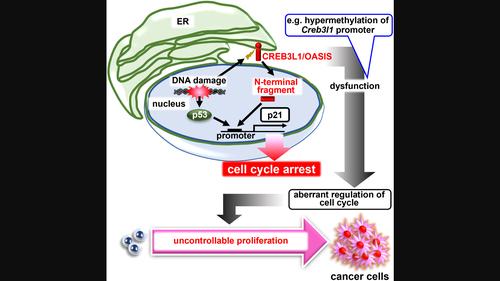Our official English website, www.x-mol.net, welcomes your feedback! (Note: you will need to create a separate account there.)
CREB3L1/OASIS: cell cycle regulator and tumor suppressor
The FEBS Journal ( IF 5.4 ) Pub Date : 2024-01-12 , DOI: 10.1111/febs.17052 Atsushi Saito 1 , Issei Omura 1 , Kazunori Imaizumi 1
The FEBS Journal ( IF 5.4 ) Pub Date : 2024-01-12 , DOI: 10.1111/febs.17052 Atsushi Saito 1 , Issei Omura 1 , Kazunori Imaizumi 1
Affiliation

|
Cell cycle checkpoints detect DNA errors, eventually arresting the cell cycle to promote DNA repair. Failure of such cell cycle arrest causes aberrant cell proliferation, promoting the pathogenesis of multiple diseases, including cancer. Endoplasmic reticulum (ER) stress transducers activate the unfolded protein response, which not only deals with unfolded proteins in ER lumen but also orchestrates diverse physiological phenomena such as cell differentiation and lipid metabolism. Among ER stress transducers, cyclic AMP-responsive element-binding protein 3-like protein 1 (CREB3L1) [also known as old astrocyte specifically induced substance (OASIS)] is an ER-resident transmembrane transcription factor. This molecule is cleaved by regulated intramembrane proteolysis, followed by activation as a transcription factor. OASIS is preferentially expressed in specific cells, including astrocytes and osteoblasts, to regulate their differentiation. In accordance with its name, OASIS was originally identified as being upregulated in long-term-cultured astrocytes undergoing cell cycle arrest because of replicative stress. In the context of cell cycle regulation, previously unknown physiological roles of OASIS have been discovered. OASIS is activated as a transcription factor in response to DNA damage to induce p21-mediated cell cycle arrest. Although p21 is directly induced by the master regulator of the cell cycle, p53, no crosstalk occurs between p21 induction by OASIS or p53. Here, we summarize previously unknown cell cycle regulation by ER-resident transcription factor OASIS, particularly focusing on commonalities and differences in cell cycle arrest between OASIS and p53. This review also mentions tumorigenesis caused by OASIS dysfunctions, and OASIS's potential as a tumor suppressor and therapeutic target.
中文翻译:

CREB3L1/OASIS:细胞周期调节因子和肿瘤抑制因子
细胞周期检查点检测 DNA 错误,最终阻止细胞周期以促进 DNA 修复。这种细胞周期停滞的失败会导致异常的细胞增殖,促进包括癌症在内的多种疾病的发病机制。内质网(ER)应激传感器激活未折叠蛋白反应,它不仅处理内质网腔内的未折叠蛋白,还协调多种生理现象,例如细胞分化和脂质代谢。在内质网应激传感器中,环状AMP反应元件结合蛋白3样蛋白1(CREB3L1)[也称为老星形胶质细胞特异性诱导物质(OASIS)]是一种内质网驻留跨膜转录因子。该分子通过受调节的膜内蛋白水解作用被裂解,然后作为转录因子被激活。OASIS 优先在特定细胞中表达,包括星形胶质细胞和成骨细胞,以调节它们的分化。正如其名称一样,OASIS 最初被认为在长期培养的星形胶质细胞中由于复制应激而经历细胞周期停滞,其表达上调。在细胞周期调节的背景下,人们发现了 OASIS 以前未知的生理作用。OASIS 作为转录因子被激活,以响应 DNA 损伤,诱导 p21 介导的细胞周期停滞。尽管 p21 直接由细胞周期的主调节因子 p53 诱导,但 OASIS 诱导的 p21 或 p53 之间不发生串扰。在这里,我们总结了 ER 驻留转录因子 OASIS 先前未知的细胞周期调节,特别关注 OASIS 和 p53 之间细胞周期停滞的共性和差异。这篇综述还提到了 OASIS 功能障碍引起的肿瘤发生,以及 OASIS 作为肿瘤抑制因子和治疗靶点的潜力。
更新日期:2024-01-12
中文翻译:

CREB3L1/OASIS:细胞周期调节因子和肿瘤抑制因子
细胞周期检查点检测 DNA 错误,最终阻止细胞周期以促进 DNA 修复。这种细胞周期停滞的失败会导致异常的细胞增殖,促进包括癌症在内的多种疾病的发病机制。内质网(ER)应激传感器激活未折叠蛋白反应,它不仅处理内质网腔内的未折叠蛋白,还协调多种生理现象,例如细胞分化和脂质代谢。在内质网应激传感器中,环状AMP反应元件结合蛋白3样蛋白1(CREB3L1)[也称为老星形胶质细胞特异性诱导物质(OASIS)]是一种内质网驻留跨膜转录因子。该分子通过受调节的膜内蛋白水解作用被裂解,然后作为转录因子被激活。OASIS 优先在特定细胞中表达,包括星形胶质细胞和成骨细胞,以调节它们的分化。正如其名称一样,OASIS 最初被认为在长期培养的星形胶质细胞中由于复制应激而经历细胞周期停滞,其表达上调。在细胞周期调节的背景下,人们发现了 OASIS 以前未知的生理作用。OASIS 作为转录因子被激活,以响应 DNA 损伤,诱导 p21 介导的细胞周期停滞。尽管 p21 直接由细胞周期的主调节因子 p53 诱导,但 OASIS 诱导的 p21 或 p53 之间不发生串扰。在这里,我们总结了 ER 驻留转录因子 OASIS 先前未知的细胞周期调节,特别关注 OASIS 和 p53 之间细胞周期停滞的共性和差异。这篇综述还提到了 OASIS 功能障碍引起的肿瘤发生,以及 OASIS 作为肿瘤抑制因子和治疗靶点的潜力。



























 京公网安备 11010802027423号
京公网安备 11010802027423号